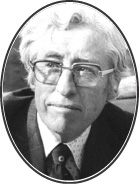
Trevor (“Jim”) Dinning was born in Adelaide on 16 February 1919 and died on 22 September 2003 after a long illness terminating in renal failure. He was the chief architect of neurosurgical services in South Australia and the creator of a very successful research foundation.
After graduating in medicine from the University of Adelaide in 1942, Jim served as an army medical officer in several units, including the North Australian Observer Unit, charged with detecting Japanese landings. However, he developed pulmonary tuberculosis and was incapacitated for some 2 years.
After his recovery, he took an appointment as lecturer in anatomy at the University of Adelaide. He decided to make a career in neurosurgery, and in 1951 he went to Guy’s Hospital in London to undergo specialist training. From the outset he had the qualities of a good neurosurgeon: an unhurried and meticulous operative technique and a total commitment to the welfare of patients.
Jim returned to Australia in 1953 to take up an appointment, initially as Honorary Assistant Neurosurgeon, at the Royal Adelaide Hospital (RAH), where he remained for the next 30 years under various titles. From 1953 to 1971 he was also Chief of Neurosurgery in what is now the Women’s and Children’s Hospital. In 1971 he became full-time Director of Neurosurgery at the RAH. In both hospitals he established modern neurosurgical units, with rigorous attention to quality control and case audits. The development of an integrated state-wide neurosurgical service was very largely Jim’s achievement. He gave special attention to the needs of Australians living in rural areas and was ahead of his time in planning how to manage head injuries in remote locations.
On a national level, Jim was a major force in creating neurosurgical training systems in Australia, beginning around 1970, when he was president of the Neurosurgical Society of Australasia. He helped to place promising trainees in overseas units with good research facilities, where they learned skills that have since helped to make Adelaide a leading centre for head-injury research. In 1964 he created what is now the Neurosurgical Research Foundation. As NRF President, Jim initiated fundraising for an academic chair in neuroscience. His vision was realised in 1992 with the establishment of a chair of neurosurgery research at the University of Adelaide.
Jim was liked and trusted by his colleagues, and admired as a superb diagnostician, teacher and scholar. He was warm and compassionate towards his patients, and had a long and fulfilling life with his wife Beatrice and his four children. After official retirement, he continued to treat patients with intractable pain at the Memorial Hospital. His other retirement activities included bee keeping and sheep breeding.
The many memorials to Jim’s achievements include the RAH’s Dinning Neuroscience Library, the Neurosurgical Research Foundation, and the legacy of his practice and teaching, which are now part of the fabric of Australian neurosurgery.





